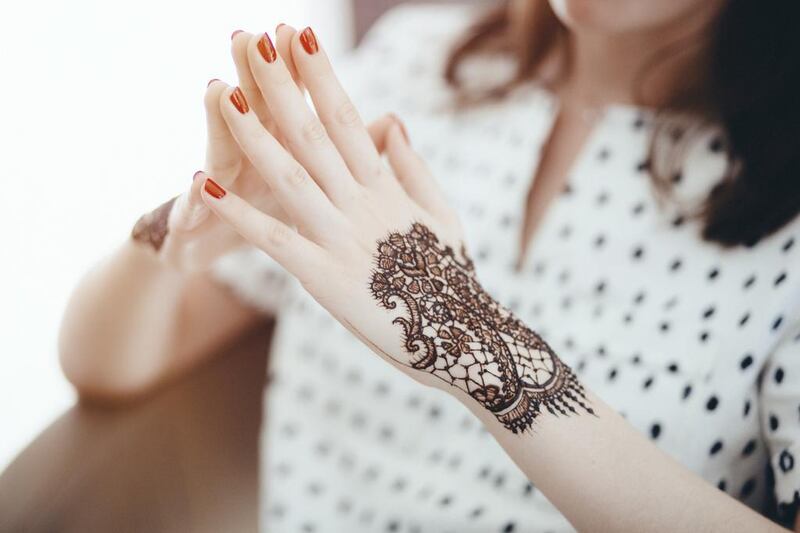The pungent smell of henna is one that I know far too well. Family members would often gang up to persuade me to surrender my hands to a henna artist during our Pakistani weddings. Even then, I would only settle for a thin bracelet on one hand, while others would fill their palms with labyrinths of vines and flowers, from their fingertips to the crevices of their wrists, and often on both sides of their hands. I preferred something less conspicuous, lacking the patience for the lengthy, messy drying process, and insecure about how my classmates would react. Throughout my upbringing in an American school, henna was not "cool". Rather, it was the mark of something alien, viewed to be foreign and strange.
Over the past year or two, however, something changed. I’m now first in line at weddings to have my henna applied, and jump at the chance to put it on for Eid, too – and it’s not because I’ve grown to appreciate my South Asian heritage. Before the artist can begin, I pull out my phone, prepared with photos that I’ve saved of inspirational henna ideas. Gone are the customary paisleys and peacocks representative of traditional henna – in their place are deviant drawings incorporating jagged tribal stripes, chevrons and arrows with occasional commercial icons such as birds or musical notes. One photo in particular shows a blogger’s outfit post from London Fashion Week. The hand that grasps her skull-studded leather clutch is covered in a decadent henna design comprising various rings around her fingers. In other images, henna-adorned hands can be seen in the same frames as cut-off denim shorts, Nike trainers and matte black manicures. Henna, evidently, is an art form that has gone viral.
Henna, or mehndi, as it is called in Hindi and Urdu, has been used throughout South Asia, Africa and the Middle East for thousands of years to mark celebratory occasions, from weddings in India to circumcisions in Morocco. It’s extracted from Lawsonia inermis, a plant that thrives in warm climates. The custom of applying henna is laden with symbolism – in South Asian cultures, it’s said that the darker the colour of henna on a bride’s hands, the more her mother-in-law will love her, and that until it fades completely, the bride does not have to do any housework. One tradition even involves incorporating the groom’s name into the elaborate illustration on the bride’s hands. In North Africa, symbols would be drawn in henna to promote fertility and to ward off the “evil eye”.
It’s unlikely that most of today’s henna users are aware of these age-old meanings. A quick search of henna hashtags on Instagram shows that DIY enthusiasts around the world are using the concoction in their own innovative ways, inspired by tradition but giving their work a contemporary edge.
Whereas the henna of the past was usually densely drawn and almost completely filled, this neo-henna is more spaced-out and often covers only the fingers or a portion of the hand. A henna trend of late has been to imitate the look of a fingerless glove – perhaps an ode to Karl Lagerfeld’s signature leather-clad palms. Henna artists produce the image in different ways – some using traditional strokes of vines and lines; others drawing flowers within lace motifs or painting delicate grids to create a fishnet effect. Also in vogue are rosary-inspired depictions, where henna is used to replicate the image of prayer beads wrapped around the fingers. In such instances, henna acts as semi-permanent jewellery, with immaculate detail given to the chains and decorative charm tassels.
One henna artist, Sara Vazir, believes that in the UAE, henna is something of a natural accessory for women. “No outfit is complete without some organic arm candy, and henna can be seen at all events, from fashion launches to everyday get-togethers,” she says. Vazir started her business, Sara’s Henna, five years ago, and has observed the spread of the trend internationally. Earlier this year, she gave a presentation on henna at a TEDx talk in Hong Kong, and she also attended the 2014 Henna Conference in Los Angeles.
Wearing a black paisley-print jumpsuit with an off-white lace cardigan, Vazir manoeuvres her henna cone with a speedy artistic flourish, effortlessly recreating her signature lace boudoir gloves on a client at the Dubai-based Snob salon and boutique, located on Al Wasl Road. Since its launch about a year ago, Snob has quickly become a local favourite, offering sought-after services like chic manicures, braided up-dos and flash tattoos, all within an upscale, shabby-chic atmosphere. Aware of the pull and popularity of henna, the managing partners Resham Khan and Haya Jhail introduced henna at Snob this past Eid season, and invited Vazir to apply it onto clients. Between Snob’s existing clientele and Vazir’s social media following, 120 clients booked up the available slots for the day, many requesting Vazir’s popular lace gloves.
Some clients like to have their henna further customised, and ask for particular names or quotes to be incorporated into the design. It's common to see text like "freedom", "hope" and even "hakuna matata" (a Swahili phrase meaning "no worries" that was popularised by The Lion King) or Arabic words for "love", "faith" and "happiness" spelt out in henna. Many in this region prefer black henna instead of the traditional red-brown colour, since it bears more of a resemblance to authentic tattoos, which are not typically endorsed in Islam. Since it's only temporary, black henna provides them with a way to get around the tattoo taboo. But because of reported skin infections and allergic reactions, black henna is banned here – under orders from the public-health department in Abu Dhabi, salons are regularly inspected to ensure their compliance. "There's no such thing as real black henna – it's actually just hair dye," explains Vazir, who makes her own henna using henna leaves, eucalyptus oil, lemon and sugar.
In the Middle East, we’re increasingly pushing the boundaries of henna into the realm of mainstream tattoos, while on the other hand, westerners are enthralled by its natural, exotic allure. Last year, Rihanna made headlines for getting an actual tattoo on her hand that was inspired by traditional henna, and the blogger-turned-model Nyane Lebajoa followed suit soon after. Perhaps this celebrity stamp of approval and nod towards eastern heritage has contributed to the growing henna trend locally, triggering the mad rush for henna during Eid and wedding seasons. “Because it’s so socially acceptable, girls love to experiment with unique designs,” says Khan.
While “experimental” henna perseveres, the art form continues to advance within a traditional framework, too. Vazir takes great care to personalise the henna designs of her brides by creating unique, customised designs for each. “I portray the bride’s love story using motifs such as skylines, landmarks, portraits of her and her groom and the scene of her proposal,” she explains. “It makes the henna special and creates a beautiful fusion of traditional and modern.”
There’s no tension between traditional henna and the current henna craze – the two thrive together, and will likely remain resilient in the mainstream. “Henna is ingrained in the culture of the UAE,” points out Khan. Vazir is confident in its everlasting trend appeal. “Henna art keeps gaining momentum and exposure, and because social media keeps spreading designs worldwide, I don’t think the fad will be dying [out] anytime soon,” she says.
At Snob, I let Vazir try out her latest henna sketch on my hand. Inspired by the prints on her clutch, she combines bold stripes with an exotic patch of flowers, complete with the padlock from the purse. It’s a pattern never seen before in henna. As I drive home. I wonder whether this design will be all the rage next Eid season? We’ll have to wait and see.
weekend@thenational.ae
Follow us @LifeNationalUAE
Follow us on Facebook for discussions, entertainment, reviews, wellness and news.





